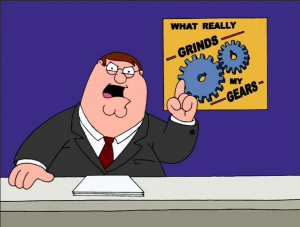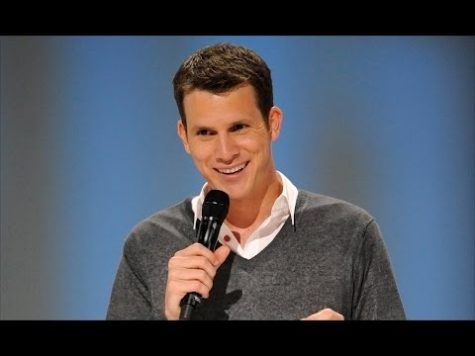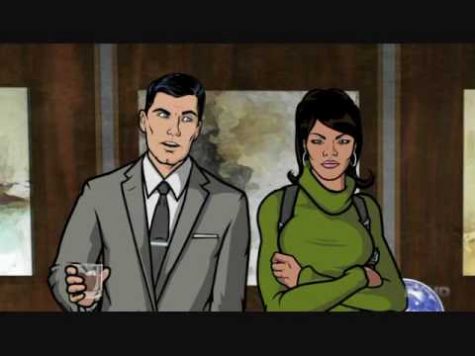What’s everybody laughing about?
A photon doesn’t ever have to check his bags at the airport. He’s travelling light.

If there is literally one and only one thing that I take seriously, it’s being funny. Not only being funny; knowing humor is important to me. There are whole books written it, on the psychology and philosophy and ideals that underline our enjoyment of comedy in general. Article after article tries to pin down the underlying theories of humor. However, it’s impossible to know quite what makes something funny, because humor is evolving almost as fast as our understanding of it.

The attempts to understand and quantify the importance of humor starts back with Aristotle. The great and well known philosopher said that our ability to laugh was one of the qualities that made us human. He proposed that since humans are the only animals that laugh, laughter has to be one of the defining aspects of our humanity. Beyond philosophy, physiological studies have been done on our laughter.
Laughing is great exercise and is an important tool in our communication. Robert Provane, Psychologist and Neuroscientist at the University of Maryland, recorded thousands of instances of laughter to conclude that less than 20% of our laughs on any given day are connected to humor. Most are used as conversational queues, normally as a way to denote a lack of ideas, a pause, or any other situation that can be mended by laughter, providing the conversation with a reparative sense of familiarity and congeniality. Laughter is just as much a form of communication as it is a response, but what is it a response to?
And therein lies the bulk of this essay, humor theory. We still don’t know quite what makes something funny, but we have ideas. There are five theories of humor that are more widely accepted (as summarized by Slate.com), but all of them have critical follies. I’ll explain them in brief.

Superiority Theory
This theory was proposed by Thomas Hobbes that explains our enjoyment of insults and, by logical extension, physical humor. In Hobbes’s own words, our laughter and enjoyment in insults is from the “sudden wave of superiority we feel over the victim.” Speaking psychologically, the greater the enjoyment and laughter, the greater the ease it give to the insulter. If someone is highly sensitive about their appearance and they make a fat joke, they will find great enjoyment in the temporary feeling of bodily security. Physical humor is then derived, in my own side of logic, from our performance superiority over the failing party. This isn’t a part of Hobbes’s theory, just my own addendum.
Furthermore, self-deprecating humor could be an extension of our own superiority over our faults. When we make a bald joke with full knowledge of our own thinning hair, we feel superior to our own faults. However, this cannot stand as a unifying theory of humor because there are more than just insults in the comedy world. More than anything, Hobbes explains the reasons behind bullying and ridicule.
This theory works on all terms, it just doesn’t cover enough to be considered a unified humor theory. Our need for superiority, and the gratification we claim from it, can definitely be viewed as a cause for laughter, but is it a cause for humor?

Incongruity Resolution Theory
This theory is among the oldest explanations for humor. It occurs when there is a lapse between what we should expect to happen and what actually happens. This is most humor. Just plain ridiculousness. When the Beast kills so many knights in Holy Grail, it’s funny because it’s just a bunny. When Deadpool talks to the audience directly it’s funny because he’s a character and he shouldn’t be able to talk to the viewer. When Family Guy makes an obscure pop culture reference, it forces us to recall amusing information in a place and way that we don’t expect.
This theory, among being the oldest, is one of the more solid ones. It is fairly accepted for a reason. However, it doesn’t explain things like insults too well, and it doesn’t explain sub humor, the new wave of surrealist humor that preys on living outside the bounds of expectation. It also doesn’t necessarily cover every form or referential humor. Why is it funny when The Simpsons references an iconic but overall unfunny scene from Pulp Fiction? Is it simply that we didn’t expect to recall the information or that we didn’t expect to remember an enjoyable time that we had watching the film?
Another subset to this theory explains that, in essence, the enjoyment we take from humor is that we are forming a new thought entirely. When presented with two conflicting thoughts our brain has no option but to combine them to form a new, conflicting, and nonsensical thought. When Tom from Tom and Jerry runs into an ironing board we don’t expect his body to bend into a “V” shape because that isn’t how physics work, so when he does bend our brain forms the new thought that people stretch into strange shapes when they collide with objects. This thought is contradictory to prior knowledge and works against our instinctual understanding of collision, therefore our brain decides to laugh because that is the only thing left to do with the information.

Similarly, this works with our perception of wordplay . When we are presented with a joke that utilizes a pun or other form of wit, we are forced to associate to characteristically asymmetric elements based on the fact that they sound the same. The better the pun, the more unlike the objects and situations.
This works with the idea of laughter being the only conclusion the brain reaches in the absence of logic. More on that later.
Critics of this theory claim that other incongruities aren’t funny. For example, a detuned instrument. However, I disagree. Picture this, two people sit together to play guitar. The camera is obviously being held by a begrudging third party as the duo prepare to astonish Instagram with their skills. One begins to play the rhythm, making a nice, delicate sound around E minor. She hums along with it creating a beautiful harmony. As the song goes on it gets louder and faster as the second person prepares to join. Finally, at the crescendo, he strums hard to produce an over-based, out of tune strum while lens-flare envelopes the camera and a high context aware filter is applied to the screen. Suddenly it transitions into a rap beat remixed over the Calliou theme song while clips of people fighting play in the background.
The video I just described doesn’t exist, but I hope it will someday. You likely experienced a disconnect with the actual comedic value at some point. That derives from what I like to call the “stupid limit.” There is a point at which the incongruity is so far removed from the original expectation that the events are considered unrecognizable. This is the stupid limit. The video described was funny at first because it was a horrible mock of—or a parody of—an Instagram video that I’m sure we’ve all seen. But at some point it lost its point, maybe. At some point you may have thought it was now dumb sounding. That is simply the upward limit of your tolerance towards bending logic.
This theory neatly explains the appeal of satire and parody through the exploitation of social trends or an original work. Both bend the logic of their respective victims to point out their flaws. This also explains the appeal of the standard joke format, set-up punch line. The set up establishes its own rules and logic and the punchline forces you to reconsider that very logic.

Dark humor then derives its value from the removal or exploitation of the logic of our own mortality. We don’t expect a joke to involve something as sacred as death, so when it does it gets an extra layer of funny.
Self-deprecating humor
Same with self-deprecating humor. We don’t expect someone to poo on themselves in a joke, so when they do we don’t know why they would say that about themselves. Our brain doesn’t get the logical appeal, so we laugh.
If you couldn’t tell by this point, this theory has the most to it.

Self-deprecating, satire, parody, nonsense, and dark humor—all falling nicely in incongruity resolution—all are also examples of postmodernism as a humor style. Postmodernism fits so nicely into comedy because it acts as the complete opposite of almost any form of narrative. The goal of any narrative is to elevate its central characters or ideas to the status of “symbolic.” The goal of postmodern humor is to take symbolic ideas (satire to social norms, existing narrative to parody, self-esteem to self-deprecating, life and religion to dark humor, and accepted logic to nonsense humor, and existence and meaning to nihilistic humor) and remove, critique, or criticize their symbolic meaning. Narrative builds something up while postmodernism tears things down.

Posthumor/anti humor
This is the subset of humor that comes from Norm Macdonald or Daniel Tosh. Simply, it’s when things are funny because they shouldn’t be. Either this comes from them being so unbearably offensive or so obscurely referential or surreal or cringe-worthy that they break any form of logic to our sense of humor we’ve built. Shock humor utilizes this. When something that shouldn’t be joked about comes in the form of a joke we lose all our thoughts on what was supposed to be funny. Anti-humor makes a joke of our sense of humor in general. Something is so benignly nonsensical or horrendous that it is funny, simple as that.
It’s all about limits. How far can something go before it’s stupid?
With that all explained, let’s move on.
Benign Violation Theory
This one is omnipresent. When something that should happen doesn’t, that’s benign violation. Here is the flaw, it is part of all of humor. People shouldn’t hurt one another, which is why insults can be funny. However, given the context of an insult, from a friendly jibe to a schoolyard bully, the humor of an insult can be completely lost. Now, some would say that that is only because we let things like fear or empathy get in the way of our enjoyment.
Basically, we would find anything that goes against the human ideas of solidarity and kindness funny if we weren’t human. This theory can be extended to the idea that everything is funny as long as it doesn’t make perfect sense, but our human emotions like empathy and fear and faith keep us from finding humor in the random, chaotic, and cruel nature of things. And so, we only find humor in the nonsense that falls within our purview of sanity and morality. This one may be true, but it is depressing, so we tend to ignore it. This is the message that the Joker tends to try and push. Life is all a joke, we are just too nice or scared to laugh.
On the lighter side, this explains the comedy of irony. Whereas a psychopath like the Joker can claim the hilarity of humans searching for meaning when there is none, we can all appreciate the value of someone putting a bottle of wine in the “back to school” section of the grocery store. Again, it’s about tolerance. Rather than the tolerance of stupidity, it’s our tolerance towards the joke itself. This form of humor bends to someone’s philosophy. A true cynic wouldn’t scoff at a joke about how horrible all man is, but a prude wouldn’t find the humor in a tire truck getting a flat.
This theory also explains everything in Incongruity Resolution Theory. Given that we hold each of the ideas that Incongruity resolution breaks as fact, then the punchline of each joke then breaks that fact and can therefore be considered a Benign Violation. Since it covers everything it’s hard to disprove.

Mechanical Theory
This one is simple. Rather than an underlying theory of all humor, it simply explains our satisfaction at a repetition of events that we can predict. Every catchphrase from “Yabba Dabba Doo” to “Bazinga” to “Wubba Lubba Dub Dub” to “Phrasing” follows this. It all just depends on how satisfying the catch phrase it to you. We are Pavlov’s dogs and every time Michael Scott says “That’s what she said,” we get trained to laugh.
Release Theory
Fifth and Freud-aly we have this theory. This is just Freud being weird again. He says that we find things funny because our brain is searching for a reason to laugh, and our brain wants a reason to laugh because laughter, according to him, is the release, of course, of pent up sexual energy. Ha ha.
And so now you know humor theory. Those are the reasons we laugh and the reasons we find things funny. From subverting what we think should happen to breaking logic and morality to insults to…Freud, it all leads to one question. And the answer to this question would then be the answer to all humor theory. What’s everybody laughing about?














